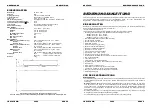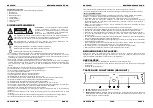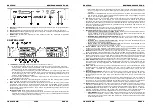
ENGLISH
OPERATION MANUAL
JB SYSTEMS
®
3/56
MCD2.2
Due to safety reasons it is prohibited to make unauthorized modifications to the unit.
INSTALLATION GUIDELINES:
Placing and using the unit for long periods near heat-generating sources such as amplifiers, spotlights,
etc. will affect its performance and may even damage the unit.
Take care to minimize shocks and vibrations during transport.
When installed in a booth or flight case, please make sure to have good ventilation to improve heat
evacuation of the unit.
To avoid condensation to be formed inside, allow the unit to adapt to the surrounding temperatures when
bringing it into a warm room after transport. Condense sometimes prevents the unit from working at full
performance.
Choose the place where you put your installation very carefully. Avoid presence of heat sources. Avoid
places with vibrations or places that are dusty and humid.
The player will work normally when installed on a surface with max. 15° inclination.
Be very careful while handling CDs, do not touch them with wet or dirty hands.
Discs that are dirty must be cleaned with special designed cloth and cleaning products.
Do not use CDs that are badly damaged (scratched or deformed) they can damage your appliance.
To prevent fire or shock hazard, do not expose this appliance to rain or moisture.
In order to prevent electric shock, do not open the top cover. If a problem occurs, contact your dealer.
Do not place metal objects or spill liquid inside the CD player. Electric shock or malfunction may result.
This CD player uses the semiconductor laser. To allow you to enjoy music at a stable operation, it is
recommended to use this in a room of 5°C – 35°C.
The compact disc player should not be adjusted or repaired by anyone except properly qualified service
personnel.
This unit may cause interference to radio and television reception.
CLEANING THE CD-PLAYER:
Clean by wiping with a polished cloth slightly dipped with water. Avoid getting water inside the unit. Do not
use volatile liquids such as benzene or thinner which will damage the unit.
CONNECTIONS
Connect the mini-DIN8 cable between the control unit and the main unit (CD loader)
Use the supplied cinch cables to connect the audio outputs of the CD player with the CD or line inputs on
your mixing unit.
Connect the mains cable.
CONTROLS AND FUNCTIONS (MAIN UNIT)
1. POWER ON/OFF switch:
switches the CD-player on and off.
2. DISC TRAY
: Use the OPEN/CLOSE buttons to open disc tray and put the CD in place.
3. OPEN/CLOSE button
: press this button to open and close the disc tray. These buttons are disabled
during playback. If the tray is not closed after 60sec. It will close automatically to prevent damage.
ENGLISH
OPERATION MANUAL
JB SYSTEMS
®
4/56
MCD2.2
4. CONTROL connector:
connect this connector to the control unit, using the supplied mini-DIN8 cable.
5. AUDIO outputs:
Output for the audio signals from the CD-player. Use the supplied cinch/cinch cable to
connect this output to a CD/line input of your mixing unit.
6. DIGITAL OUT socket:
Use this connector to connect the digital signal (S/PDIF format) to the input of a
digital amplifier or digital recorder (ex. Mini disc)
7. MAINS input:
connect the CD player to the 230V AC mains, using the supplied power-cord.
CONTROL UNIT
1. JOG WHEEL:
This jog wheel serves 3 functions depending on the mode you are working in.
The jog wheel acts as a slow frame search (1/75sec) control when the CD is not playing but either
paused or set to a cue point. To set a new cue point, spin the wheel then press PLAY or LOOP IN
when you have determined the proper position. Press CUE to return to the “CUE POINT”.
If the track is playing and the fast search function (16) is not active, the jog wheel temporarily bends
the pitch of the music up to +/-32% by rotating the wheel clockwise to speed it up or
counterclockwise to slow it down. The amount of pitch change is determined by the speed of
rotation.
If the fast search function (16) is active, you will be able to search at a higher speed through the
current track.
2. LOOP IN button:
Allows you to set the cue point without stopping the playback (CUE ON THE FLY).
This button also sets the beginning of a seamless loop.
3. LOOP OUT button:
Used to set the endpoint when looping music. The player starts to loop seamlessly
until you press this button again to exit. When a loop is programmed but not active you can also restart
the loop. The point where you press the button will be memorized as the new end point of the loop. In
loop edit mode pressing the OUT button stops the loop editing and saves the new loop endpoint.
4. RELOOP/STUTTER button:
This button has 3 functions:
RELOOP:
When a loop was programmed and you have hit the OUT button, press the reloop button
to enter the loop again. To exit the loop press the OUT button. (intro and end points of the loop are
unchanged)
STUTTER:
When a loop is playing you can press this button to restart the loop at once. You can also
press this button when a track is not playing in loop. Every time the RELOOP/STUTTER button is
pressed, it will restart the music from the preprogrammed cue point. The stutter effect adds extra
creativity to your performance.
Summary of Contents for mcd 2.2
Page 1: ......





































